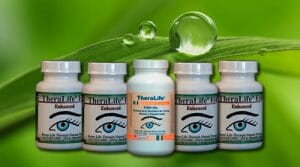Eyes light sensitive? – Get Help from TheraLife
Light sensitivity is a hall mark of chronic dry eyes.
Treat your dry eyes to get rid of light sensitivity.
How do dry eyes cause light sensitivity?
Dry eye syndrome makes the cornea more sensitive to light. In addition, researches have shown that computer users tend to blink less as they work on the computer for long periods. Computer use can result in dry eyes. Theralife has the complete oral dry eye treatment protocol for light sensitivity recovery.
Who suffers from light sensitivity?
Light sensitivity is common among people with chronic dry eyes, severe headaches, migraines, viral diseases, and blepharospasm.
What are the symptoms associated with light sensitivity (photophobia)?
Light sensitivity, also called photophobia, is an abnormal intolerance for light. Light sources such as sunlight, fluorescent, or other artificial lights trigger discomfort.
The person with light sensitivity will squint or have to close their eyes. Light sensitivity can cause pain, tears, and headaches.
The brighter the light, the greater the discomfort. People with this condition are affected by bright lights, but any light can trigger symptoms in extreme cases. The wavelength of the light may also matter. For example, blue light generally causes more trouble than other colors.
Significant changes in light levels can cause light sensitivity. For example, if you often spend time in darkened rooms, you will be less used to brighter lights and notice them more.
How is light sensitivity diagnosed?
If you are experiencing severe light sensitivity, you should consult an eye physician. Your doctor will perform a physical examination and also examine your eyes. Tell your doctor about the frequency and severity of your symptoms, as this will help them determine the cause.
Causes of light sensitivity
The exact area of the brain that causes light sensitivity is unknown. Light is carried in the visual pathways to the brain via the retina. The retina contains cells that detect light and form and projects them onto the optical path through the optic nerve. The light sensitivity may be partially caused by the rods and cones not recovering efficiently.
The retina also contains cells that sense light. Once these cells get turned on, these cells do not turn off.
Both types of cells in the retina may be involved in light sensitivity. These cells connect with the trigeminal system located in the deep brain center – and this explains how bright lights can cause pain. The melanopsin system also explains why people who are blind and thus have no formed vision can still experience light sensitivity.
Technically, photophobia is a symptom of another condition. Causes of light sensitivity include severe headaches, migraines, virus-caused illnesses, or blepharospasm (eye twitch). Uveitis, dry eyes, thinning of the retina, corneal abrasion, and nervous system disorders such as meningitis, encephalitis, and subarachnoid hemorrhage can also cause photophobia. It can also be a symptom of contact lens irritations, detached retina, refractive surgery, and sunburn.
Photophobia may also be a symptom of thyroid conditions or diabetes.
Dry eye syndrome makes the cornea more sensitive to light. In addition, researches have shown that computer users tend to blink less as they work on the computer for long periods. Therefore, computer overuse can result in dry eyes.
Color deficiencies in photophobia dry eye treatment
People with light eye colors are more likely to experience this condition because they contain less pigment, protecting the eyes from bright lights. Albinism is the lack of eye pigment, and it can have photophobia.
Light sensitivity can also be associated with total color deficiency (see only shades of gray), mercury poisoning, keratitis, iritis, rabies, botulism, and conjunctivitis.
Rare diseases in dry eye treatment
Light sensitivity can happen in rare diseases such as keratosis follicularis spinulosa decalvans (KFSD), a genetic disorder.
Medications in dry eye treatment
Some medications can have light sensitivity as a side effect. Some of these medications include doxycycline, tetracycline, diuretics such as furosemide, anti-malarial drugs such as quinine, antihistamines, blood pressure medications, digoxin, belladonna, and photosensitizing drugs can have this effect.
Prognosis of light sensitivity caused by dry eyes
The prognosis varies depending on the underlying cause of the condition.
With dry eyes, at least it is treatable – see TheraLife solution below.
Treatment for light sensitivity.
The only way to substantially reduce light sensitivity is to address the underlying cause. In many cases, removing the light sensitivity triggers is all it takes to cure this issue.
If photophobia is a side effect of a medication, sometimes your doctor can discontinue or replace the drug.
Treating migraines and blepharospasm may be helpful since they are the two most common causes of light sensitivity. Dry eyes can complicate chronic photophobia. Typical use of traditional dry eye treatments such as artificial tears, gels, and ointments is common.
Intermittent light sensitivity associated with migraines usually reduces with the use of migraine medications. Preventive migraine treatments can also help.
To alleviate the discomfort caused by photophobia, you should avoid direct sunlight and bright room lights, particularly fluorescent lights. If necessary, stay in a darkened room or wear sunglasses or glare control glasses. Some people find that tinted lenses help, particularly FL-41 tint, blue-blocking lenses, or red lenses.
Other natural treatments for dry eyes and light sensitivity.
Carotenoids – Eat more carrots
Research studies have shown that visual performance improves and light sensitivity (glare) decreases in subjects taking carotenoids (10 mg lutein and 2 mg zeaxanthin) per day.
Green leafy vegetables such as spinach, kale, and yellow carrots. have high levels of Lutein. Zeaxanthin is the pigment that gives paprika, corn, and saffron (and some other plants) their characteristic color.
Fruits and vegetables are an excellent way to obtain carotenoids. Daily juicing is a perfect form to promote intake.
Nutrients to preserve vision include bilberry, vinpocetine, l-lysine, some vitamins and enzymes, and fish oil. They are available as supplements.
Take TheraLife Eye capsules if you have dry eyes.
If you are sensitive to the glare of headlights at night, you may need prescription glasses for night driving. See your eye doctor determine if that would be helpful. Keeping your eyes focused more on the edge of the road rather than approaching headlights may help you avoid the glare.
If you find that you have become very sensitive to light- visit a physician to determine the underlying cause of this condition. Sometimes it can be a symptom of severe disease.
How TheraLife Can Help
Any questions, call toll free 1-877-917-1989 US/Canada, International 650-949-6080
Email to: [email protected]
Frequently Asked Questions
Can dry eyes cause sensitivity to light?
Yes, dry eyes can cause sensitivity to light. It is a hallmark symptom of chronic dry eyes. Come to Theralife for help.
How do you fix dry sensitive eyes?
You can fix light sensitive eyes by treating dry eyes with TheraLife. Oral treatments from inside out. All natural remedy that works. Clinically proven.
Why are my eyes suddenly sensitive to light?
Conclusion
In conclusion, there continues to be growing evidence in the literature that dry eye disease negatively impacts quality of life and visual function across more domains than healthcare providers may realize. This may explain the paradigm shift in eye care now homing in on assessing visual function as opposed to ocular discomfort symptoms alone. While multiple questionnaires are currently available to quantify the effects of dry eye in clinical practice, dry eye diagnosis often remains missed during common clinical testing. Improved standards in patient care will remain dependent on doctors being more cognizant of how significantly tear film pathology can negatively affect their patient’s visual function day by day.
References
- The epidemiology of dry eye disease: report of the Epidemiology Subcommittee of the International Dry Eye WorkShop. The ocular surface. 2007;5(2):93–107. [
- Kalangara JP, Galor A, Levitt RC, et al. Characteristics of Ocular Pain Complaints in Patients With Idiopathic Dry Eye Symptoms. Eye & contact lens. 2016
- Pouyeh B, Viteri E, Feuer W, et al. Impact of ocular surface symptoms on quality of life in a United States veterans affairs population. American journal of ophthalmology. 2012;153(6):1061–1066. e1063.
- Schiffman RM, Walt JG, Jacobsen G, Doyle JJ, Lebovics G, Sumner W. Utility assessment among patients with dry eye disease. Ophthalmology. 2003;110(7):1412–1419.
- Amini A, Digre K, Couldwell WT. Photophobia in a blind patient: An alternate visual pathway. Case report. Journal of neurosurgery. 2006;105(5):765–768.
- Okamoto K, Thompson R, Tashiro A, Chang Z, Bereiter DA. Bright light produces Fos-positive neurons in caudal trigeminal brainstem. Neuroscience. 2009;160(4):858–864.
- Digre KB, Brennan KC. Shedding light on photophobia. Journal of neuro-ophthalmology : the official journal of the North American Neuro-Ophthalmology Society. 2012;32(1):68–81.
- Meng ID, Hu JW, Benetti AP, Bereiter DA. Encoding of corneal input in two distinct regions of the spinal trigeminal nucleus in the rat: cutaneous receptive field properties, responses to thermal and chemical stimulation, modulation by diffuse noxious inhibitory controls, and projections to the parabrachial area. Journal of neurophysiology. 1997;77(1):43–56.
- Aicher SA, Hegarty DM, Hermes SM. Corneal pain activates a trigemino-parabrachial pathway in rats. Brain research. 2014;1550:18–26.
- Aicher SA, Hermes SM, Hegarty DM. Corneal afferents differentially target thalamic- and parabrachial-projecting neurons in spinal trigeminal nucleus caudalis. Neuroscience. 2013;232:182–193.
- Fernandez CA, Galor A, Arheart KL, et al. Dry eye syndrome, posttraumatic stress disorder, and depression in an older male veteran population. Investigative ophthalmology & visual science. 2013;54(5):3666–3672.
- Marfurt CF. Sympathetic innervation of the rat cornea as demonstrated by the retrograde and anterograde transport of horseradish peroxidase-wheat germ agglutinin. The Journal of comparative neurology. 1988;268(2):147–160.
- Davis L, Pollock L. The role of the sympathetic nervous system in the production of pain in the head. Arch Neurol Psychiatry. 1932;27:282–293.
- Katz BJ, Digre KB. Diagnosis, Pathophysiology and Treatment of Photophobia. Survey of ophthalmology. 2016
- Xue T, Do MT, Riccio A, et al. Melanopsin signalling in mammalian iris and retina. Nature. 2011;479(7371):67–73.
- Guthoff RF, Wienss H, Hahnel C, Wree A. Epithelial innervation of human cornea: a three-dimensional study using confocal laser scanning fluorescence microscopy. Cornea. 2005;24(5):608–613.
- Parra A, Gonzalez-Gonzalez O, Gallar J, Belmonte C. Tear fluid hyperosmolality increases nerve impulse activity of cold thermoreceptor endings of the cornea. Pain. 2014;155(8):1481–1491.
- Woolf CJ. Central sensitization: implications for the diagnosis and treatment of pain. Pain. 2011;152(3 Suppl):S2–15.
- Noseda R, Burstein R. Migraine pathophysiology: anatomy of the trigeminovascular pathway and associated neurological symptoms, cortical spreading depression, sensitization, and modulation of pain. Pain. 2013;154(Suppl 1):S44–53.
- Ren K, Dubner R. Neuron-glia crosstalk gets serious: role in pain hypersensitivity. Current opinion in anaesthesiology. 2008;21(5):570–579.
- Chiang CY, Wang J, Xie YF, et al. Astroglial glutamate-glutamine shuttle is involved in central sensitization of nociceptive neurons in rat medullary dorsal horn. The Journal of neuroscience : the official journal of the Society for Neuroscience. 2007;27(34):9068–9076.
- Burstein R, Jakubowski M, Garcia-Nicas E, et al. Thalamic sensitization transforms localized pain into widespread allodynia. Annals of neurology. 2010;68(1):81–91.
- Galor A, Zlotcavitch L, Walter SD, et al. Dry eye symptom severity and persistence are associated with symptoms of neuropathic pain. The British journal of ophthalmology. 2015;99(5):665–668.
- Galor A, Batawi H, Felix ER, et al. Incomplete response to artificial tears is associated with features of neuropathic ocular pain. The British journal of ophthalmology. 2016;100(6):745–749.
- Kremer M, Salvat E, Muller A, Yalcin I, Barrot M. Antidepressants and gabapentinoids in neuropathic pain: Mechanistic insights. Neuroscience. 2016
- Mehta S, McIntyre A, Janzen S, Loh E, Teasell R Spinal Cord Injury Rehabilitation Evidence T. Systematic Review of Pharmacologic Treatments of Pain After Spinal Cord Injury: An Update. Archives of physical medicine and rehabilitation. 2016
- Jones RC, 3rd, Lawson E, Backonja M. Managing Neuropathic Pain. The Medical clinics of North America. 2016;100(1):151–167.
- Fine PG, Digre KB. A controlled trial of regional sympatholysis in the treatment of photo-oculodynia syndrome. Journal of neuro-ophthalmology : the official journal of the North American Neuro-Ophthalmology Society. 1995;15(2):90–94.





